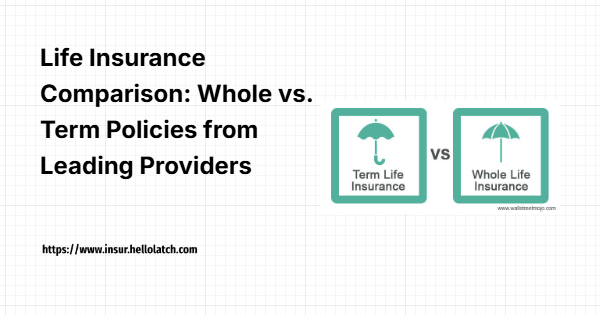
When it comes to securing financial protection for your loved ones, life insurance is one of the most important investments you can make. However, choosing between a whole life insurance policy and a term life insurance policy can be challenging. Each type of policy offers unique benefits, and understanding the differences is key to selecting the right plan for your needs. In this article, we’ll compare whole life and term life insurance from leading providers to help you make an informed decision.
What is Term Life Insurance?
Term life insurance provides coverage for a specified period, usually 10, 20, or 30 years. If you pass away during this term, your beneficiaries will receive a death benefit. Once the term ends, the coverage expires, and you no longer have life insurance unless you choose to renew or convert the policy. Term life is often seen as a more affordable option compared to whole life insurance, making it a popular choice for individuals who need financial protection during certain stages of life, such as while raising children or paying off a mortgage.
Key Features of Term Life Insurance:
- Lower Premiums: Term policies typically have lower monthly premiums than whole life policies, making them more affordable for many people.
- Fixed Term: Coverage is in place for a set period, which can be a benefit for those looking for temporary financial protection.
- No Cash Value: Term policies don’t accumulate cash value, meaning you won’t receive any money back if you outlive the policy.
- Flexibility: Many term policies allow you to convert to whole life insurance at the end of the term, though this may come with higher premiums.
Top Providers of Term Life Insurance:
- State Farm – Known for competitive pricing and flexibility in term lengths.
- Haven Life – Offers a streamlined application process with a strong digital experience.
- Banner Life – Provides affordable premiums and excellent customer support.
What is Whole Life Insurance?
Whole life insurance, on the other hand, provides lifelong coverage. As long as you continue to pay your premiums, the policy will remain active for your entire life. Unlike term life insurance, whole life policies have a cash value component that grows over time, making them a more complex and long-term financial product. This cash value can be borrowed against or withdrawn, though it may reduce the death benefit if not repaid.
Key Features of Whole Life Insurance:
- Lifelong Coverage: Whole life insurance provides coverage that lasts your entire life, as long as premiums are paid.
- Cash Value: Whole life policies build cash value over time, which can be used for loans, withdrawals, or as an investment.
- Higher Premiums: Whole life insurance is more expensive than term life insurance due to the lifelong coverage and cash value accumulation.
- Predictable Premiums: Your premiums for whole life insurance remain fixed, providing long-term financial stability.
Top Providers of Whole Life Insurance:
- New York Life – One of the most trusted names in the industry, offering customizable whole life policies.
- MassMutual – Known for strong dividends and the ability to tailor policies to meet individual needs.
- Northwestern Mutual – Offers a wide range of whole life options, including high-quality cash value growth.
Whole Life vs. Term Life: Which is Right for You?
Choosing between whole life and term life insurance ultimately depends on your financial goals, budget, and how long you want to be covered.
Whole Life Insurance:
- Best for individuals who want lifelong protection and the potential to build savings or wealth over time.
- Ideal for people looking to leave a legacy or provide a financial cushion for heirs.
- A good choice for those who can afford the higher premiums and are looking for stability in their financial planning.
Term Life Insurance:
- Best for those who need affordable coverage for a specific period, such as while paying off a mortgage or raising children.
- Ideal for individuals who are looking for temporary protection at a lower cost and do not need a cash value component.
- Great for people who are just starting to build their financial portfolio and need coverage on a budget.
Conclusion:
Both whole and term life insurance policies have their advantages. Whole life insurance offers permanent coverage and a cash value component, while term life insurance is an affordable option that provides coverage for a set period. When selecting a life insurance policy, it’s essential to evaluate your financial situation, goals, and the needs of your loved ones. If you’re looking for long-term protection and financial growth, whole life insurance might be the right choice. However, if you need a more affordable option for a specific time frame, term life insurance is likely a better fit.
By understanding the differences between whole and term life insurance and researching providers, you can select a policy that provides the right coverage for your circumstances. Be sure to compare quotes from various companies and consult with an insurance professional to ensure you’re making the best choice for your future.

Leave a Reply